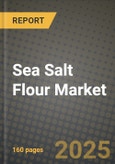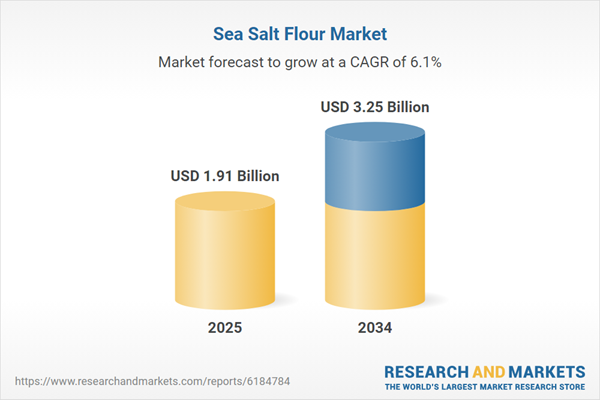Sea Salt Flour Market
The Sea Salt Flour Market covers finely milled sea-derived sodium chloride engineered for rapid solubility, uniform flavor delivery, and clean-label positioning across bakery, snacks, dairy, meat and seafood processing, sauces and seasonings, ready meals, and foodservice. Distinct from table or rock salt fines, sea salt flour offers controlled particle-size distributions, improved adhesion for topical applications, and trace-mineral narratives tied to origin. Demand is propelled by premiumization of foods, sodium-reduction programs that leverage smaller crystals for higher perceived saltiness at equal or lower dosages, and the growth of gourmet seasonings and rubs, and chef-driven applications. Manufacturers prioritize flow stability, anti-caking without additives, and compatibility with mixers, injectors, and slurry systems. New product development explores flavored and smoked variants, blends with potassium salts and taste modulators, and microfine grades that dissolve in cold systems, plant-based matrices, and emulsions. Moisture and caking control, corrosion management, and hygienic handling are critical; packaging with barrier liners and humidity indicators protects performance in humid geographies. Competitive dynamics span marine salt producers with onshore refining, specialty mills offering narrow granulometry, and vacuum/rock salt players positioning ultra-fines as substitutes. Differentiation centers on sensory uniformity, origin storytelling, process efficiencies, and regulatory assurance around contaminants and allergens. As brands rationalize ingredient lists, sea salt flour enables “sea salt” callouts while supporting cost-in-use via lower application weights and reduced rework from uneven coverage. Growth follows snack and bakery modernization, premium private label, plant-based prepared foods, and HORECA recovery, with sustainability narratives - solar evaporation, regional sourcing, and recyclable packaging - enhancing appeal and procurement scorecards.Sea Salt Flour Market Key Insights
- Particle engineering as a performance lever
- Sodium reduction via size - not substitutes alone
- Clean label and origin storytelling drive trade-ups
- Application science differentiates suppliers
- Moisture and caking control are make-or-break
- Compatibility with modern processing trains
- Flavor platforms expand beyond plain salt
- Private label premiumization accelerates adoption
- Regulatory and quality governance underpin scale
- Sustainability narratives influence procurement
Sea Salt Flour Market Reginal Analysis
North America
Demand is anchored in snacks, artisanal bakery, and clean-label retail where “sea salt” signals quality. Large CPGs and private labels adopt microfine grades to meet sodium targets without taste loss, pushing tight specs on particle size, flow, and anti-caking. Foodservice recovery favors chef-ready, flavored sea salt flours for rubs and finishing. Moisture management is central in Gulf and coastal climates, driving barrier packaging and humidity controls. Supplier selection emphasizes allergen governance, heavy-metal assurance, and reliable lead times with regional safety stock to ride seasonal snack spikes and retail resets.Europe
Provenance and sustainability weigh heavily, with solar-evaporated Mediterranean sources and recyclable packaging aiding listings. Sodium-reduction policies and retailer scorecards accelerate use of microfine sea salt to preserve taste while cutting dose. Premium bakery and gourmet snacks demand uniform adhesion and color-stable flavored variants. Strict contaminant and additive scrutiny lifts suppliers with audited anti-caking strategies and documented change control. Logistics strategies prioritize short lanes and moisture-safe warehousing in maritime climates, while private label programs standardize granulometry across multi-country assortments to streamline production and quality checks.Asia-Pacific
Scale manufacturing of snacks, instant foods, and bakery drives high-volume grades, while urban premium segments adopt flavored and smoked variants. Humid monsoon climates require robust caking mitigation and corrosion-resistant handling. Sodium-reduction initiatives rise in advanced markets, favoring microfine sizes and partial potassium blends. Regional sourcing from coastal producers supports cost and ESG narratives, and e-commerce brands leverage “sea salt” cues for differentiation. Technical support on topical adhesion and rapid dissolution in cold systems helps stabilize quality across diverse substrates, line speeds, and plant skill levels.Middle East & Africa
Growth centers on modern retail, hospitality, and snack expansion, with sea salt flour enabling premium cues on simple ingredient lists. High ambient temperatures and variable humidity prompt strict storage protocols, barrier-lined packaging, and controlled dispensing to prevent caking. Import programs emphasize consistent granulometry, contaminant assurance, and halal certification. Flavored variants gain traction in quick-service and grill concepts for rubs and marinades. Distributors with cold-chain-aware warehousing, corrosion-safe transfer equipment, and training on topical application techniques outperform in protecting yield and sensory consistency.South & Central America
Snack, bakery, and seasoning houses adopt sea salt flour for premium positioning and sodium management. Regional producers and coastal imports balance cost and provenance stories, while humidity and logistics variability increase reliance on barrier packaging and desiccant programs. Private label growth favors suppliers that deliver repeatable adhesion, tight particle specs, and anti-caking approaches suited to tropical climates. Flavored sea salt flours support grill and street-food traditions; buyers prioritize allergen governance, heavy-metal controls, and responsive local stock to navigate promotional peaks and short production runs.Sea Salt Flour Market Segmentation
By Type
- Coarse Grain
- Fine Grain
By Application
- Food Processing Industry
- Foodservice Industry
- Retail/Household
Key Market players
Cargill Salt, Morton Salt (K+S), Compass Minerals, Salins Group, Tata Chemicals (Tata Salt), Salt of the Earth Ltd., Cheetham Salt, Maldon Salt Company, Cornish Sea Salt Co., SaltWorks Inc., San Francisco Salt Company, Jacobsen Salt Co., Celtic Sea Salt (Selina Naturally), Sal de Ibiza GmbH, Hellenic Saltworks S.A., Olsson’s Salt, Walvis Bay Salt Holdings, China National Salt Industry Group (CNSIG), Vietnam National Salt Corporation (Visalco), SalmarimSea Salt Flour Market Analytics
The report employs rigorous tools, including Porter’s Five Forces, value chain mapping, and scenario-based modelling, to assess supply-demand dynamics. Cross-sector influences from parent, derived, and substitute markets are evaluated to identify risks and opportunities. Trade and pricing analytics provide an up-to-date view of international flows, including leading exporters, importers, and regional price trends.Macroeconomic indicators, policy frameworks such as carbon pricing and energy security strategies, and evolving consumer behaviour are considered in forecasting scenarios. Recent deal flows, partnerships, and technology innovations are incorporated to assess their impact on future market performance.
Sea Salt Flour Market Competitive Intelligence
The competitive landscape is mapped through proprietary frameworks, profiling leading companies with details on business models, product portfolios, financial performance, and strategic initiatives. Key developments such as mergers & acquisitions, technology collaborations, investment inflows, and regional expansions are analyzed for their competitive impact. The report also identifies emerging players and innovative startups contributing to market disruption.Regional insights highlight the most promising investment destinations, regulatory landscapes, and evolving partnerships across energy and industrial corridors.
Countries Covered
- North America - Sea Salt Flour market data and outlook to 2034
- United States
- Canada
- Mexico
- Europe - Sea Salt Flour market data and outlook to 2034
- Germany
- United Kingdom
- France
- Italy
- Spain
- BeNeLux
- Russia
- Sweden
- Asia-Pacific - Sea Salt Flour market data and outlook to 2034
- China
- Japan
- India
- South Korea
- Australia
- Indonesia
- Malaysia
- Vietnam
- Middle East and Africa - Sea Salt Flour market data and outlook to 2034
- Saudi Arabia
- South Africa
- Iran
- UAE
- Egypt
- South and Central America - Sea Salt Flour market data and outlook to 2034
- Brazil
- Argentina
- Chile
- Peru
Research Methodology
This study combines primary inputs from industry experts across the Sea Salt Flour value chain with secondary data from associations, government publications, trade databases, and company disclosures. Proprietary modeling techniques, including data triangulation, statistical correlation, and scenario planning, are applied to deliver reliable market sizing and forecasting.Key Questions Addressed
- What is the current and forecast market size of the Sea Salt Flour industry at global, regional, and country levels?
- Which types, applications, and technologies present the highest growth potential?
- How are supply chains adapting to geopolitical and economic shocks?
- What role do policy frameworks, trade flows, and sustainability targets play in shaping demand?
- Who are the leading players, and how are their strategies evolving in the face of global uncertainty?
- Which regional “hotspots” and customer segments will outpace the market, and what go-to-market and partnership models best support entry and expansion?
- Where are the most investable opportunities - across technology roadmaps, sustainability-linked innovation, and M&A - and what is the best segment to invest over the next 3-5 years?
Your Key Takeaways from the Sea Salt Flour Market Report
- Global Sea Salt Flour market size and growth projections (CAGR), 2024-2034
- Impact of Russia-Ukraine, Israel-Palestine, and Hamas conflicts on Sea Salt Flour trade, costs, and supply chains
- Sea Salt Flour market size, share, and outlook across 5 regions and 27 countries, 2023-2034
- Sea Salt Flour market size, CAGR, and market share of key products, applications, and end-user verticals, 2023-2034
- Short- and long-term Sea Salt Flour market trends, drivers, restraints, and opportunities
- Porter’s Five Forces analysis, technological developments, and Sea Salt Flour supply chain analysis
- Sea Salt Flour trade analysis, Sea Salt Flour market price analysis, and Sea Salt Flour supply/demand dynamics
- Profiles of 5 leading companies - overview, key strategies, financials, and products
- Latest Sea Salt Flour market news and developments
Additional Support
With the purchase of this report, you will receive:- An updated PDF report and an MS Excel data workbook containing all market tables and figures for easy analysis.
- 7-day post-sale analyst support for clarifications and in-scope supplementary data, ensuring the deliverable aligns precisely with your requirements.
- Complimentary report update to incorporate the latest available data and the impact of recent market developments.
This product will be delivered within 1-3 business days.
Table of Contents
Companies Mentioned
- Cargill Salt
- Morton Salt (K+S)
- Compass Minerals
- Salins Group
- Tata Chemicals (Tata Salt)
- Salt of the Earth Ltd.
- Cheetham Salt
- Maldon Salt Company
- Cornish Sea Salt Co.
- SaltWorks Inc.
- San Francisco Salt Company
- Jacobsen Salt Co.
- Celtic Sea Salt (Selina Naturally)
- Sal de Ibiza GmbH
- Hellenic Saltworks S.A.
- Olsson’s Salt
- Walvis Bay Salt Holdings
- China National Salt Industry Group (CNSIG)
- Vietnam National Salt Corporation (Visalco)
- Salmarim
Table Information
| Report Attribute | Details |
|---|---|
| No. of Pages | 160 |
| Published | November 2025 |
| Forecast Period | 2025 - 2034 |
| Estimated Market Value ( USD | $ 1.91 Billion |
| Forecasted Market Value ( USD | $ 3.25 Billion |
| Compound Annual Growth Rate | 6.1% |
| Regions Covered | Global |
| No. of Companies Mentioned | 20 |









